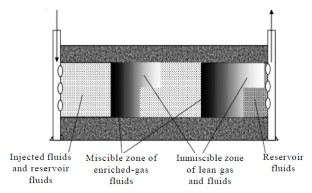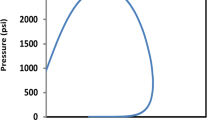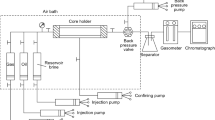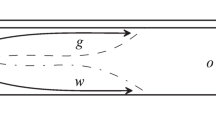An efficient optimization and design method has been proposed and developed for Enriched-gas Water-Alternating-Gas (EWAG) injection process. The proposed technique is able to quantitatively determine the sizes of the enriched-gas slug and water slug for each cycle of the water-alternating-gas (WAG) injection process, as well as the total number of injection cycles. Applying this method provides the opportunity to implement the WAG scenario more efficient and economical. The numerical simulation showed that in comparison with other conventional WAG scenarios with traditional optimization approach, the EWAG has the obvious advantages of evaluation of indices, such as the oil recovery factor and cumulative net cash flow.








Similar content being viewed by others
Abbreviations
- CGI:
-
Continuous gas injection
- LPG:
-
Liquefied petroleum gas
- MME:
-
Minimum miscible enrichment
- OOIP:
-
Original oil in place
- PV:
-
Pore volume
- ROIP:
-
Remaining oil in place
- TRF:
-
Tertiary Recovery Factor
- WAG:
-
Water-alternating-gas
- WF:
-
Water flooding
References
A. Arya, T. A. Hewett, R. G. Larson, and L. W. Lake, “Dispersion and reservoir heterogeneity,” SPE Resent. Eval. Eng., 3, No. 1, 139-148 (1988).
A. R. Awan, R. Teigland, and J. Kleppe, “A survey of North Sea enhanced-oil-recovery projects initiated during the years 1975 to 2005,” SPE Reserv. Eval. Eng., 11, No. 3, 497-512 (2008).
L. Bermudez, R. T. Johns, and H. C. Parakh, “Parametric investigation of WAG floods above the MME,” SPE J., 12, No. 2, 224-234 (2007).
J. R. Christensen, E. H. Stenby, and A. Skauge, “Review of WAG field experience,” SPE Reserv. Eval. Eng., 4, No. 2, 97-106 (2001).
S. Chen, H. Li, D. Yang, and P. Tontiwachwuthikul, “Optimal parametric design for water-alternating-gas (WAG) process in a CO2miscible flooding reservoir,” J. Can. Pet. Technol., 49, No. 10, 75-82 (2010).
T. E. H. Esmaiel, S. Fallah, and C. P. J. W. van Kruijsdijk, “Determination of WAG ratios and slug sizes under uncertainty in a smart wells environment,” SPE 93569, 14th SPE Middle East Oil and Gas Show and Conference, Bahrain International Exhibition Centre, Bahrain (2005).
R. E. Hadlow, “Update of industry experience with CO2 injection,” In SPE Annual Technical Conference and Exhibition, Society of Petroleum Engineers (1992).
L. W. Holm and V. A. Josendal, “Discussion of determination and prediction of CO2 minimum miscibility pressures,” J. Pet. Technol., 32, No. 5 (1980).
E. T. S. Huang and L.W. Holm, “Effect of WAG injection and wettability on oil recovery during carbon dioxide flooding,” SPE 15491, 1986 Annual Technical Conference and Exhibition, New Orleans, LA, U.S.A. (1986).
R. T. Johns, F. J. Fayers, and F. M. Orr, “Effect of gas enrichment and dispersion on nearly miscible displacements in condensing/vaporizing drives,” SPE Adv. Technol. Ser., 2, No. 2, 26-34 (1993).
M. M. Kulkarni, “Immiscible and miscible gas-oil displacements in porous media,” Master’s thesis, The Craft and Hawkins Department of Petroleum Engineering, University of Pune, India (2003).
L. L. Lo, D. S. McGregor, and P. Wang, “WAG pilot design and observation well data analysis for HassiBerkine South Field,” SPE 84076, SPE Annual Technical Conference and Exhibition, Denver, Colorado, U.S.A. (2003).
T. D. Ma, J. A. Rugen, R. F. Stoisits, and G. K. Youngren, “Simultaneous water and gas injection pilot at the Kuparuk River Field, reservoir impact,” SPE Annual Technical Conference and Exhibition, 22-25 October, Dallas, Texas, U.S.A. (1995).
J. Mahadevan, L. W. Lake, and R. T. Johns, “Estimation of true dispersivity in field scale permeable media,” SPE/DOE Improved Oil Recovery Symposium, 13-17 April, Tulsa, Oklahoma, U.S.A. (2002).
D. T. Raj, R. Slamet, K. Charles, A. K. Farihan, A. B. Mohamad, R. T. O. Tengku, and B. Nazrin, “Maximizing the oil recovery through immiscible water alternating gas (IWAG) in mature offshore field,” SPE:133345- MS, SPE Asia Pacific Oil and Gas Conference and Exhibition, Brisbane, Queensland, Australia (2010).
J. D. Rogers and R. B. Grigg, “A literature analysis of the WAG injectivity abnormalities in the CO2 process,” SPE Reserv. Eval. Eng., 4, No. 5, 375-386 (2001).
G. M. Rouzbeh and W. L. Larry, “Simultaneous water-gas-injection performance under loss of miscibility,” SPE: 129966-MS, SPE Improved Oil Recovery Symposium, Tulsa, Oklahoma, U.S.A. (2010).
A. Skauge and E. I. Dale, “Progress in immiscible WAG modelling,” SPE/EAGE Reservoir Characterization and Simulation Conference, 28-31 October, Abu Dhabi, UAE (2007).
M. Sohrabi, D. H. Tehrani, A. Danesh, and G. D. Henderson, “Visualization of oil recovery by water-alternating-gas injection using high-pressure micromodels,” SPE J., 9, No. 3, 290-301 (2004).
R. Solano, R. T. Johns, and L. W. Lake, “Impact of reservoir mixing on recovery in enriched-gas drives above the minimum miscibility enrichment,” SPE Reserv. Eval. Eng., 4, No. 5, 358-365 (2001).
F. L. Stalkup, “Effect of gas enrichment and numerical dispersion on enriched-gas-drive predictions,” SPE Reserv. Eval. Eng., 5, No. 4, 647-655 (1990).
L. M. Surguchev, R. Korbol, and O. S. Krakstad, “Optimum water alternate gas injection schemes for stratified reservoirs,” SPE Annual Technical Conference and Exhibition, 4-7 October, Washington, D.C., U.S.A. (1992).
R. D. Tewari, S. Riyadi, C. Kittrell, F. A. Kadir, M. Abu Bakar, T. Othman and N. Banu, “Maximizing the oil recovery through immiscible water alternating gas (IWAG) in mature offshore field,” SPE Asia Pacific Oil and Gas Conference and Exhibition, 18-20 October, Brisbane, Qeensland, Australia (2010).
M. K. Zahoor, M. N. Derahman, and M. H. Yunan, “Wag process design - an updated review,” Brat. J. Pet. Gas, 5, No. 2 (2011).
Y. Wang, “Novel existence and uniqueness criteria for periodic solutions of a Duffing type p-Laplacian equation,” Appl. Math. Lett., 23, No. 4, 436-439 (2010).
L. Zhang, Y. Wang, H. X. Li, and L. Zhang, “Periodic solutions and global attraction for N-dimension discrete-time neural networks with time-varying delays,” Bull. Belg. Math. Soc.-Simon Steven, 18, No. 3, 483-491 (2011).
J. Tian, S. Zhong, and Y. Wang, “Improved exponential stability criteria for neural networks with time-varying delays,” Neurocomputing, 97, 164-173 (2012).
X. Dai, Z. Zhang, Y. Wang, J. Li, and L. Chen, “Multi-parameter magnetoelectric response modeling of magnetostrictive/piezoelectric laminate composites considering shear strain,” J. Appl. Phys., 115, 014104 (2014).
Y. Wang and X. Y. Yi, “Some results for periodic solutions of a kind of Liénard equation,” J. Funct. Space, 519747 (2015).
Y. Wang and X. Y. Yi, “Transient pressure behavior of a fractured vertical well with a finite-conductivity fracture in triple media carbonate reservoir,” J. Porous Media, 20, No. 8, 707-722 (2017).
Y. Wang, Z. W. Tao, L. Chen, and X. Ma, “The nonlinear oil—water two-phase flow behavior for a horizontal well in triple media carbonate reservoir,” Acta Geophys., 65, No. 5, 977-989 (2017).
Y. Wang, C. Zhang, T. Chen, and X. Ma, “Modeling the nonlinear flow for a multiple-fractured horizontal well with multiple finite-conductivity fractures in triple media carbonate reservoir,” J. Porous Media, 21, No. 12, 1283-1305 (2018).
Y. Wang, C. Zhang, R. Huang, H. T. Cao, and X. Ma, “Modeling oil-water two-phase flow behavior of a fractured vertical well with a finite-conductivity fracture in triple media carbonate reservoir,” Adv. Appl. Math. Mech., 10, No. 3, 581-610 (2018).
Y. Wang, M. J. Li, X. Ma, W. B. Gao, G. Q. Xue, and J. Zhou, “Modeling the nonlinear oil-water two-phase flow behavior for a multiple-fractured horizontal well in triple media carbonate reservoir,” Adv. Appl. Math. Mech., 10, No. 4, 998-1024 (2018).
Y. Wang and X. Y. Yi, “Flow modeling of well test analysis for a multiple-fractured horizontal well in triple media carbonate reservoir,” Int. J. Nonlin. Sci. Numer Simla., 19, No. 5, 439-457 (2018).
W. Q. Wu, X. Ma, B. Zeng, Y. Wang, and W. Cai, “Application of the novel fractional grey model FAGMO(1,1,k) to predict China's nuclear energy consumption,” Energy, 165, 223-234 (2018).
W. Q. Wu, X. Ma, Y. Y. Zhang, W. P. Li, and Y. Wang, “A novel conformable fractional non-homogeneous grey model for forecasting carbon dioxide emissions of BRICS countries,” Sci. Total Environ., 707, 135447 (2020).
W. Q. Wu, X. Ma, B. Zeng, Y. Wang, and W. Cai, “Forecasting short-term renewable energy consumption of China using a novel fractional nonlinear grey Bernoulli model,” Renew. Energy, 140, 70-87 (2019).
X. Ma, W. Q. Wu, B. Zeng, Y. Wang, and X. X. Wu, “The conformable fractional grey system model,” ISA Trans., 96, 255-271 (2020).
W. Q. Wu, X. Ma, Y. Wang, Y. Y. Zhang, and B. Zeng, “Research on a novel fractional GM (alpha, n) model and its applications,” Grey Sys -- Them, Appl., 9, No. 2, 356-373 (2019).
X. Ma, M. Xie, W. Q. Wu, B. Zeng, Y. Wang, and X. X. Wu, “The novel fractional discrete multivariate grey system model and its applications,” Appl. Math. Model., 70, 402-424 (2019).
Y. Wang, D. H. Tian, G. F. Li, C. Zhang, and T. Chen, “Dynamic analysis of a fractured vertical well in triple media carbonate reservoir,” Chem. Technol. Fuels Oils, 55, No. 1, 56-65 (2019).
W. Q. Wu, X. Ma, Y. Y. Zhang, Y. Wang, and X. X. Wu, “Analysis of novel FAGM(1,1,t) model to forecast health expenditure of China,” Grey Syst. — Theory Appli., 9, No. 2, 232-250 (2019).
Y. Wang, Z. W. Tao, D. H. Tian, X. Ma, M. J. Li and Z. H. Feng, “Some novel results of T-periodic solutions for Rayleigh type equation with double deviating arguments,” Univ. Politeh. Buchar Sci. Bull. - Ser A - Appl. Math. Phys., 82 (2020).
X. Ma, W. Q. Wu, Y. Wang, B. Zeng, and W. Cai, “Predicting primary energy consumption using NDGM(l,l,k,c) model with Simpson formula,” Sci. Iran., 27 (2020).
Y. Wang, Z. W. Tao, K. Yang, X. Ma, D. H. Tian, and Z. H. Feng, “Dynamic analysis of oil-water two-phase flow for a multiple-fractured horizontal well with multiple finite-conductivity fractures in triple media carbonate reservoir,” ZAMM-Z. Angew. Math. Mech., 100, e201900046 (2020).
Y. L. Zhao, B. C. Shan, L. H. Zhang and Q. G. Liu, “Seepage flow behaviors of multi-stage fractured horizontal wells in arbitrary shaped shale gas reservoirs,” J. Geophys. Eng., 13, No. 5, 1-10 (2016).
Y. L. Zhao, L. H. Zhang, Y. Xiong, Y. H. Zhou, Q. G. Liu, and D. Chen, “Pressure response and production performance for multi-fractured horizontal wells with complex seepage mechanism in box-shaped shale gas reservoir,” J. Nat. Gas Sci. Eng., 32, 66-80 (2016).
Y. L. Zhao, L. H. Zhang, G. Q. Feng, B. N. Zhang, and B. Kang, “Performance analysis of fractured wells with stimulated reservoir volume in coal seam reservoirs,” Oil Gas Sci. Technol., 71, No. 1, 1-8 (2016).
J. J. Ren and P. Guo, “A general analytical method for transient flow rate with the stress-sensitive effect.” J. Hydrol., 565, 262-275 (2018).
J. J. Ren and P. Guo, “Analytical method for transient flow rate with the effect of the quadratic gradient term,” J. Pet. Sci. Eng., 162, 774-784 (2018).
J. J. Ren and P. Guo, “Nonlinear flow model of multiple fractured horizontal wells with stimulated reservoir volume including the quadratic gradient term,” J. Hydrol., 554, 155-172 (2017).
J. J. Ren and P. Guo, “Performance of vertical fractured wells with multiple finite-conductivity fractures,” J. Geophys. Eng., 12, No. 6, 978-987 (2015).
J. J. Ren and P. Guo, “Anomalous diffusion performance of multiple fractured horizontal wells in shale gas reservoirs,” J. Nat Gas Sci. Eng., 26, 642-651 (2015).
J. J. Ren, P. Guo and S. Peng, “Performance of multi-stage fractured horizontal wells with stimulated reservoir volume in tight gas reservoirs considering anomalous diffusion,” Environ. Earth Sci., 77, No. 22 (2018).
D. H. Tian, B. W. Yang, J. H. Chen, and Y. Zhao, “A multi-experts and multi-criteria risk assessment model for safety risks in oil and gas industry integrating risk attitudes,” Knowledge-Based Syst., 156, 62-73 (2018).
D. H. Tian, C. L. Zhao, B. Wang, and M. Zhou, “A MEMCIF-IN method for safety risk assessment in oil and gas industry based on interval numbers and risk attitudes,” Eng. Appl. Artif. Intell., 85, 269-283 (2019).
D. H. Tian, Y. Wang, and T. Yu, “Fuzzy risk assessment based on interval numbers and assessment distributions,” Int. J. Fuzzy Syst., 22 (2020).
J. Y. Xiao, S. P. Wen, X. J. Yang, and S. M. Zhong, “New approach to global Mittag-Leffler synchronization problem of fractional-order quaternion-valued BAM neural networks based on a new inequality,” Neural Netw., 122, 320-337 (2020).
J. Y. Xiao and S. M. Zhong, “Synchronization and stability of delayed fractional-order memristive quaternion-valued neural networks with parameter uncertainties,” Neurocomputing, 363,321-338 (2019).
Z. H. Feng, F. Y. Li and J. X. Liu, “Notes on a boundary value problem with a periodic nonlinearity,” Optik, 156, 439-446 (2018).
Z. H. Feng, F. Y. Li, Y. Lv, and S. Q. Zhang, “A note on Cauchy-Lipschitz-Picard theorem,” J. Inequal. Appl., 271, 1-6 (2016).
Z. H. Feng, R Wu, and H. X. Li, “Multiple solutions for a modified Kirchhoff-type equation in R^N” Math. Methods. Appl. Sci., 38, No. 4,708-725 (2015).
Z. H. Feng, X. X. Wu, and L. Yang, “Stability of a mathematical model with piecewise constant arguments for tumor-immune interaction under drug therapy,” Int. J. Bifinv. Chaos, 29, No. 1,1950009 (2019).
Acknowledgments
This work was supported by the Program of Science and Technology of Sichuan Province of China (No. 20YYJC01 45).
Author information
Authors and Affiliations
Corresponding author
Additional information
Translated from Khimiya i Tekhnologiya Topliv i Masel, No. 2, pp. 93 – 100, March – April, 2020.
Rights and permissions
About this article
Cite this article
Wang, Y., Tao, Z., Tian, D. et al. Optimizing Injection Process of Water-Alternate-Gas Using Different Produced Gas Densities in Enriched-Gas Flooding. Chem Technol Fuels Oils 56, 271–284 (2020). https://doi.org/10.1007/s10553-020-01137-3
Published:
Issue Date:
DOI: https://doi.org/10.1007/s10553-020-01137-3




